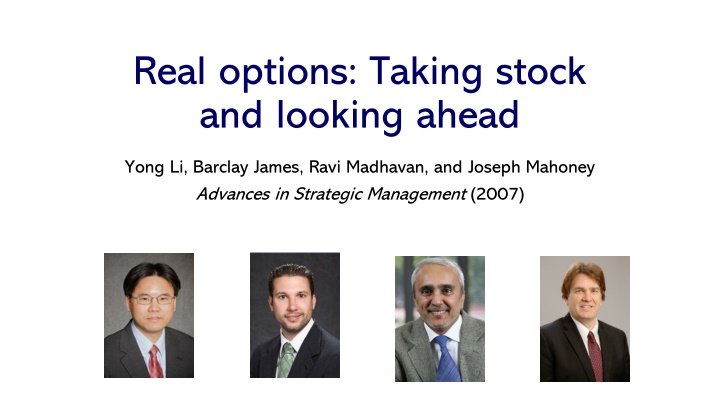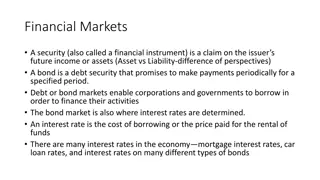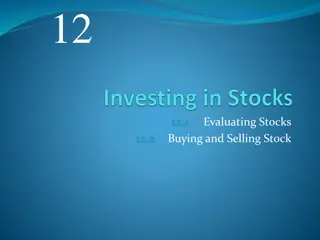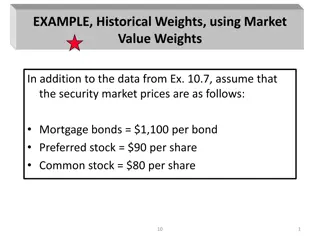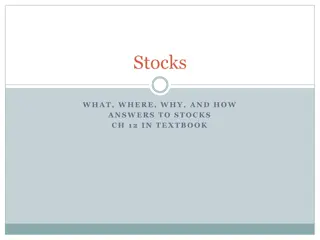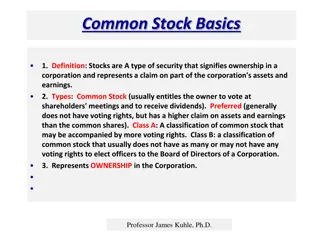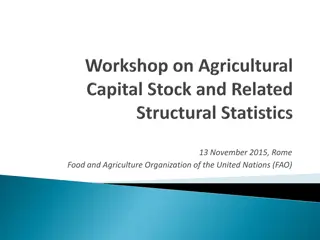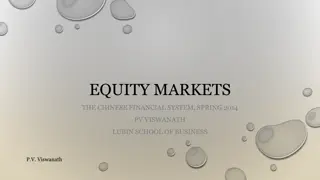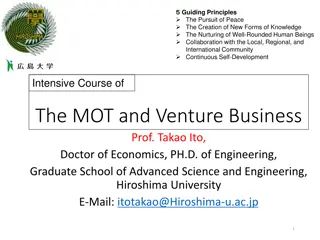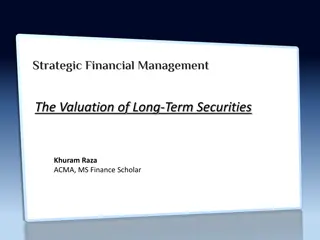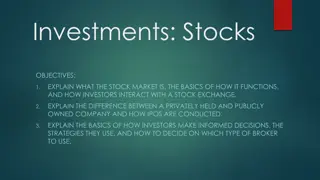Real Options: Taking Stock and Looking Ahead
Real options theory explores investment decisions utilizing flexible strategies to adapt to market uncertainties. It contrasts with traditional NPV methods by emphasizing decision rights, value creation, and strategic flexibility for managers to respond to unexpected developments.
Download Presentation

Please find below an Image/Link to download the presentation.
The content on the website is provided AS IS for your information and personal use only. It may not be sold, licensed, or shared on other websites without obtaining consent from the author.If you encounter any issues during the download, it is possible that the publisher has removed the file from their server.
You are allowed to download the files provided on this website for personal or commercial use, subject to the condition that they are used lawfully. All files are the property of their respective owners.
The content on the website is provided AS IS for your information and personal use only. It may not be sold, licensed, or shared on other websites without obtaining consent from the author.
E N D
Presentation Transcript
Real options: Taking stock and looking ahead Yong Li, Barclay James, Ravi Madhavan, and Joseph Mahoney Advances in Strategic Management (2007)
whether and when to invest or exit How to invest or organize activities
Taking Stock: Applications of Real Options Theory Common Real Options and Investment Decisions The option is real because the underlying assets are usually physical and human assets rather than financial securities. Commonalities with financial options: Rights but not obligations to take some action in the future Create economic value by generating future decision rights Provide flexibility when facing uncertainty Useful in the absence of sufficient information Differences with traditional investment theory (NPV): NPV approach fails to consider that managers can adapt and revise its strategies in response to unexpected market and technological developments that cause cash flows to deviate from their original expectations. Traditional investment theory: (1) Investment is now or never; (2) Only invest if NPV is greater than or equal to zero. Four types of options: Option to Wait-to-Invest; Options to Abandon and Switch; Growth Options; and Interaction of Options
Common Real Options and Investment Decisions Option to Wait Option to Wait- -to to- -Invest Provides strategic flexibility to defer the investment until additional information is received with the passage of time Option is more valuable with high exogenous uncertainty The time of investing: the present value of the expected cash inflows from a project must exceed the cost of the project by an amount equal to the economic value of keeping the investment option open Costly ability to wait growth options Partial irreversibility put option of abandonment Invest Option to Abandon and Switch Option to Abandon and Switch Put Option gives firms the right to abandon an investment if market conditions get worse or switch when conditions are adverse Value increases with the salvage value and future uncertainty As irreversibility increases, put option value is reduced The positive effect on investment propensity: the threshold value for the optimal decision rule is in general smaller than the full incremental costs.
Common Real Options and Investment Decisions Growth Option Call Option allows firms to make additional subsequent investments. This can also be understood as a compound option: (1) call: hold asset; (2) put: abandon/switch. Multi-stage projects: 1st stage: create --- 2nd stage: exercise Examples: R&D investment the option to commercialize; joint venture the option to acquire Interaction of Options Project value The incremental value of each additional option is usually not equal to its economic value in isolation Value is attenuated by substitute but enhanced by complementary options Substitute: the option to wait-to-invest vs the option to temporarily shut down Complementary: the option to expand vs the option to temporarily shut down Dueling: the option to wait-to-invest and growth options (preemptive effect) More uncertainty is negatively related to irreversibility.
Extension of Real Options Theory of Investment Portfolio of Options Firm decisions as bundles of real options R&D, alliances, and patenting activities as creating real options . Diversification predicts firm investment behavior and strategy: correlated alliances (sub-additive) versus non-correlated. Competition and investment Add game-theoretic perspective: competition impacts investment decisions. Industry structure (perfect competition, oligopoly, monopoly) first-mover advantage Endogenous uncertainty and learning Both types of uncertainty increase the economic value of real options Exogenous vs endogenous uncertainty: waiting vs learning opportunities Endogenous uncertainty encourages firms to invest because there is no value to waiting Exit decisions and hysteresis Delaying exit may be rational under uncertainty and irreversibility (rational inertia) Two sides of a coin: Investment may not occur until profits exceed costs by the economic value of the option to invest; similarly, investment may continue until economic losses exceed the value of the option to continue derived from profitable operations in future good states of the world.
Organization and Governance Preferred investment modes under uncertainty: When joint venture (collaboration) > acquisition (e.g. vertical integration) or internal development. When market-like mechanism > integration (strategic flexibility vs strategic commitment) In collaborative ventures Option value of acquiring or selling the venture depends on: Divergent economic valuations of the venture ex ante. Without this, no incentive to sell. Divergence of ex post valuations Asymmetric resource complementarity and learning rate. Property rights play a role in determining who gets the put or call option to sell/divest or buy. Badly assigned control rights can lead to predatory and opportunistic behavior by the privileged partner.
Valuation and Performance Implications Valuation Real options theory is fundamentally a theory of economic valuation Takes the value of managerial flexibility into account (e.g. wait-to-invest; switching; abandonment; growth). Economic value of a firm derives from assets in place + growth options Performance implications Technological competence (holding patents) in uncertainty higher market value IJVs have positive impacts on growth option values (high uncertainty). Multinationals have greater flexibility in shifting value chains, compared to domestic-only firms
The Real Options Theory of Investment Real Options, Learning and Heterogeneity Different investment patterns based on learning capabilities (Bowman & Hurry, 1993). Real Options and Game Theory Integration Real options are usually shared, and their economic value may be eroded by competition. Game theory has outstripped empirical research. Real Option Theory on Exit/Abandonment Decisions Inaction (exit delay). More research on abandonment/switching than just growth. Uncertainty and irreversibility. How this widens or narrows zone of inaction. The interaction between real options or option-like projects Firms often manage a portfolio of projects simultaneously or sequentially Effects of Uncertainty Ambiguity in the sources of uncertainty. These should be spelled out. Robustness checks.
Real Options Studies About Investment Mode Choices and The Performance Implications of Real Options Options Theory as a complementary approach to Transaction Cost Theory Contractual issues for uncertain investments. Has added dynamism to TCE: make, buy, partner. How this evolves over time sequences. Costs of creating and exercising options Flexibility RO assumes options have positive value. But cost of attainment matters. Examine firm- and industry-level influences Capturing economic value of options depends on firm and industry-specific influences. Further application Venture Capital and Entrepreneurship Clarify mixed empirical results
Issues in Implementation and Questions Issues Finding an options pricing model whose assumptions match those of the project being analyzed. How psychological processes internal to organization delimit real options theory. Determining the proper measures for the variables Solving it mathematically. Promising questions Given economic incentives problems, psychological biases and organizational processes may effect option creation: Who controls the decision rights to the option? What changes in the firm s processes are needed to manage real options? What changes in the organization are needed to capture the option value?
